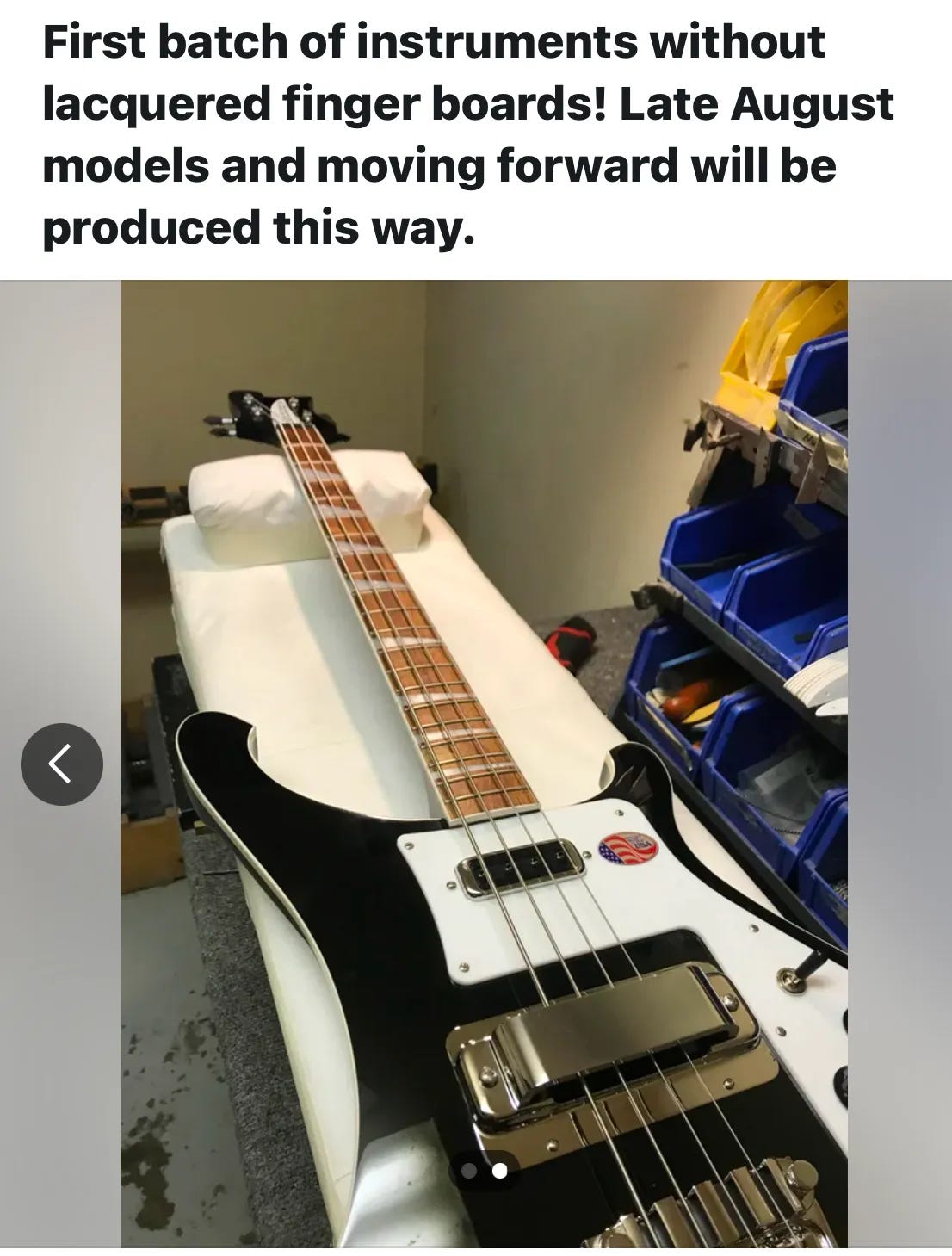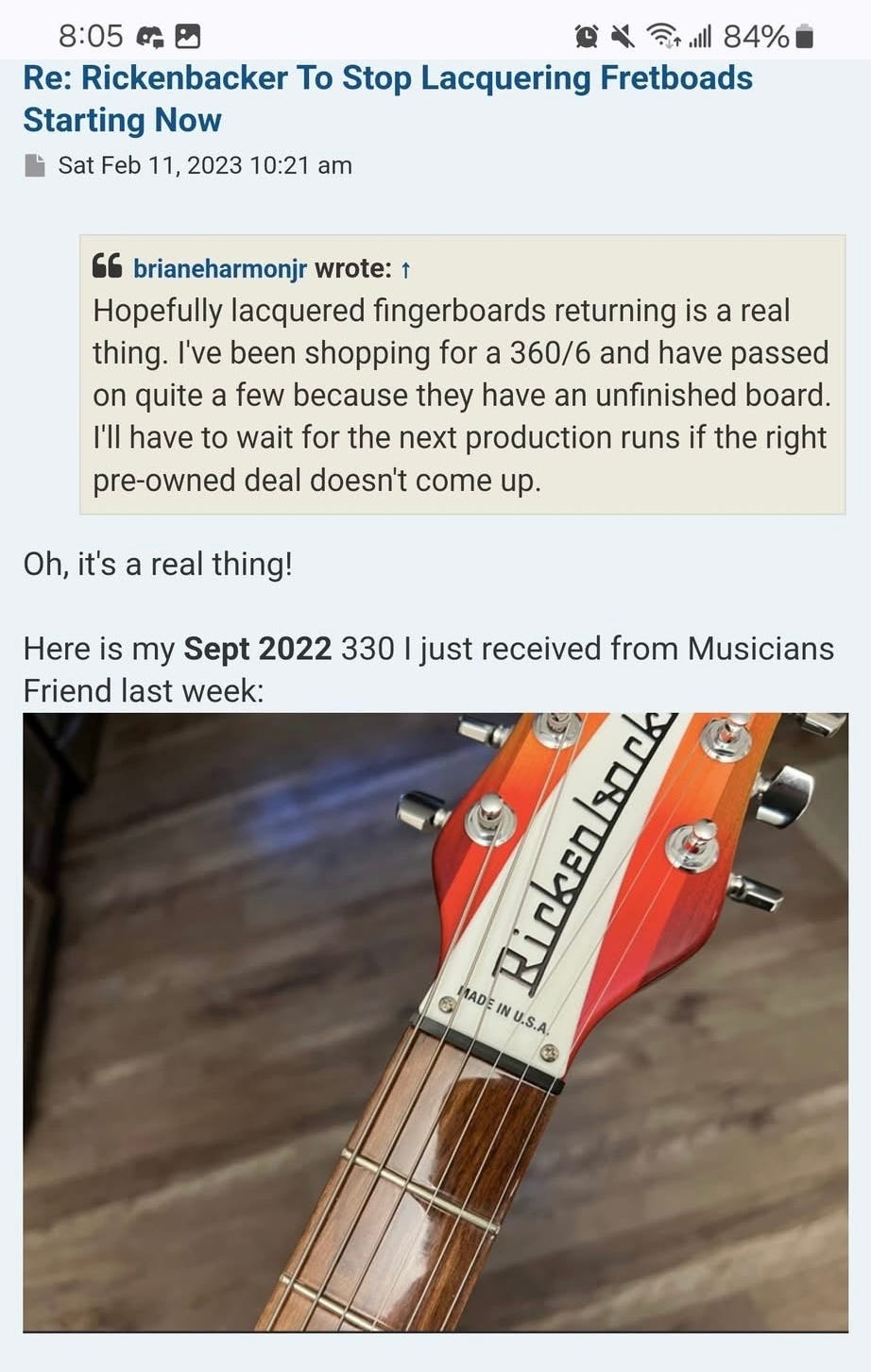Short Takes: The 2021-2022 Unfinished Fingerboards
Since the late 1950s, one of the defining characteristics of Rickenbacker guitars and basses has been their glossy finished fingerboards. Certainly models with unfinished boards have come and gone over the years, but “core” models have always had glossy finished boards. Except for the brief period when they didn’t!
In August, 2021, Rickenbacker made the following surprise announcement across social media:

The word spread across the internet like wildfire, but details were sparse. Over the next few weeks, however, those details became clear: C and V-series guitars would retain their finished boards as would the 1993 Plus and 660, but all “core” models—the 330, 360, 620, and 4003–would now feature oiled fingerboards.
The initial reaction was…mixed. It is fair to say that very few people had NO opinion on the matter! Reactions ranged from “WORST.IDEA.EVER!” to “FINALLY!”, with only a handful of “wait and sees” thrown in.
Ultimately the camps came down to this: team WORST.IDEA.EVER!’s position was that a finished board is one of Rickenbacker’s strengths and key part of what makes a Rickenbacker a Rickenbacker. Eliminating it, therefore, negatively impacted the very nature and desirability of the guitar. Team FINALLY!’s position was that the finished board was one of Rickenbacker’s greatest liabilities and its existence removed them from many people’s consideration sets. Eliminating it, therefore, positively impacted the very nature and desirability of the guitar. Not a lot of room for agreement there!
I will say, broadly speaking, that bassists were more a good bit more favorable than were guitarists. And as there are two pretty different customer pools for Rickenbacker guitars and basses, that’s not all that surprising. Let’s be frank: Rickenbacker basses are a good bit more versatile than Rickenbacker guitars, so it makes sense that you’d find more traditionalists in the guitarist pool.
So…how did it go? Well, we don’t really know the details. There was no dramatic increase or decrease in output as a result—but the guitar market was still on a post-Covid high with lots of pent-up demand, so…that doesn’t really tell us anything. I CAN tell you that a couple dealers I know told me they had passed…less-than-glowing feedback to Rickenbacker, but not of the “change it back or else!” variety.
But we can probably guess how it went, because without any notice or fanfare finished fingerboards returned across the board in September, 2022. And this time reaction was not nearly as divided—although it took a bit longer for the news to spread.

Now that it’s in the rear-view window, here’s my take. Rickenbacker in the John Hall years was pretty famous for not listening to customer feedback. And when you sell as many as you can make, there’s not a whole lot of reason or incentive to do so! But now that we’re entering the Ben Hall years, I think Ben is trying to do a better job of listening. And there certainly is a vocal group out there who thinks finished boards are not great—especially bassists. But as it is in almost everything, the loudest voices are usually not in the majority. And I think that was likely the case here.
What will the long term impact on value be for the guitars produced during this brief period? My best guess is that it will be a slight negative for guitars, and for basses I’m not quite sure—I can clearly see a market for these guitars, but I don’t know how big it will be. Regardless, I say kudos to Ben for listening and taking a chance!


I think one of the big reasons RIC tried this was their problems with UV finishing, resulting in non-adhering clearcoats.
The problem wasn’t confined to the fretboards, but that was the area where it was most conspicuous.
Having owned a 4002, and several Cheyennes i and ii, all with oil finish fretboards, I was quite in favor of the move.
My 2015 Laredo’s fretboard was really bad with large “tents” around most of the frets. Even my old 4000 had the original finish knocked down considerably when I had it refretted, and I never wanted to restore that aspect.